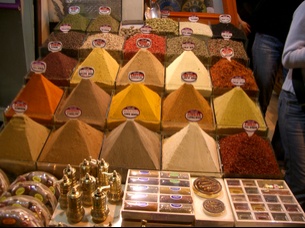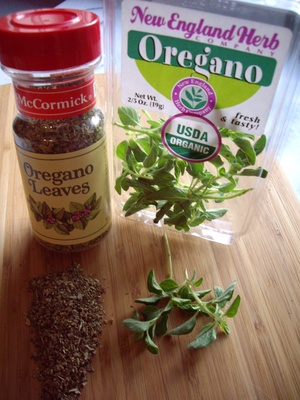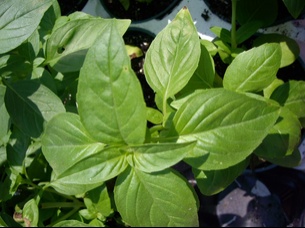
Istanbul Spice Market
Many people use the terms herbs and spices interchangeably to mean any product of plant origin used primarily for seasoning food.
By definition “a spice is a pungent or aromatic seasoning obtained from the bark, buds, fruit, roots, seeds or stem of various plants and trees.”
Some of the more popular spices used today are allspice, cardamom, cinnamon, cloves, ginger, mace, nutmeg, paprika, pepper, saffron and turmeric. Spice blends, like curry powder, chili powder, garam masala, pickling spice, cajun seasoning (Bam!), and pumpkin pie spice can be purchased at the grocery store or made at home by combining several dried spices. (Salt, often listed in the spice category, is actually a mineral and not a spice.)
Ingredients for Pumpkin Pie For Beginners
By definition an “herb is the fragrant leaves of any of various annual or perennial plants that grow in temperate zones and do not have woody stems.”
Parsley, Cilantro, and Mint
Some commonly available fresh herbs are: basil, bay leaf, cilantro, chervil, coriander, marjoram, mint, oregano, parsley, rosemary, sage, savory, tarragon and thyme.

Fresh Thyme, Rosemary and Basil
Using Herbs and Spices
Adding herbs and spices to your recipes is a great way to add a bit of pizazz to your cooking! (Just a pinch – literally what you can pinch between your thumb and forefinger – of oregano can really liven up a jar of spaghetti sauce.)
Dried, ground spices are usually measured out and added to the recipe at the beginning of the cooking process. (In Indian cooking the dried spices are handled somewhat differently. Indian food recipes usually call for whole spices that are then toasted in the fry pan – and sometimes then ground – before use. The flavors are brighter and more intense then just adding the pre-ground spice from the jar.)
Fresh herbs are usually added at the end of the cooking process. It keeps the flavor of the herb brighter. If you are using fresh herbs instead of dried the ratio is 3 to 1.

So if the recipe calls for 1 teaspoon of dried oregano, you would use 3 teaspoons of fresh oregano.
Knowing what herb/spice works with what foods is all part of the learning process. CNN has an In-Depth Food food and spice chart that will help guide you.
You do want to be careful not to overpower a recipe with too much or too many spices. The University of Delaware has an excellent description on the intensity of herbs and spices:
- Strong or dominant flavors – Includes bay leaf, cardamom, curry (actually a blend of spices), ginger, pepper, mustard, rosemary, sage
- Medium flavors – Use in moderate amounts (1 to 2 teaspoons for 6 servings) Includes basil, celery seeds and leaves, cumin, dill, fennel, French tarragon, garlic, marjoram, mint, oregano, savory, thyme, turmeric
- Delicate flavors – Includes burnet, chervil, chives, parsley. May be used in large quantities and combined with most other herbs and spices.
- Sweet flavor (combined in sweet dishes may let you reduce sugar) – Includes cinnamon, cloves, allspice, ginger, cardamom, anise, fennel, mint.
- Savory flavor – Oregano, tarragon, chives, dill
- Peppery flavor – Red pepper, mustard, black pepper, paprika. Use with care since their flavors stand out (approximately 1 teaspoon for 6 servings)”
HerbExpert “is an excellent resource on growing and cooking with herbs in a simple and clear format, with easily accessible language.”
Storage:
Both fresh herbs and dried spices tend to be expensive. Proper storage of both is really important. A trendy and beautiful spice rack may look fantastic on a kitchen counter but dried spices should NOT get stored on your kitchen counter!
Dried spices should be stored in a cool, dark, dry environment, away from direct sunlight, in air tight containers. Inside a cupboard usually works well. Be sure that the cupboard is away from the heat of the oven/microwave and away from the moisture of the dishwasher. Once your spice collection begins to grow, try to keep them in alphabetical order for easier access.
Many people label their spice jars with the date it was purchased. That is not always the best indicator of how fresh a dried spice is. A much better test is to just smell dried spices before using them. If they have lost their scent, they should get tossed into the trash.
Real Simple has some great tips on storing fresh herbs:
Basil, Parsley, and Cilantro
“A fresh bunch of basil can be treated like a bouquet of flowers: Just trim the ends, place in a glass with an inch or so of water, and place on the counter at room temperature. (The leaves will turn black if refrigerated). The basil will remain fresh for anywhere from a few days to a week. You can also try this with similar long-stemmed herbs like parsley and cilantro.”

Fresh Basil
Chives, Thyme, and Rosemary
“Other herbs, like chives, thyme, and rosemary, require a slightly different approach. Wrap them loosely in plastic wrap and place them in the warmest part of the refrigerator; one of the compartments in the door works perfectly. Do not wrap the herbs tightly or the trapped moisture may cause them to mold prematurely; many people like to add a crumpled paper towel to the bag as a safeguard. Do not rinse the herbs until just before using.”
Better Homes and Garden has some great tips on freezing herbs. They say that some herbs (like basil, chives, dill, lemongrass, mint, oregano, sage, savory-both winter and summer, sorrel, tarragon, and thyme) will keep their flavor when frozen. Simply clean the leaves, dry them, and put them in sealed plastic bags (remove all the air before sealing).
The farmer’s market near my home has little pots of fresh herbs, and I am very tempted to get a few of these pots for the window sill, but I am really bad at keeping plants alive. Then again, how hard can it be to grow basil?
Does any one have any suggestions?
If you are new to startcooking, or are a regular visitor here, please consider subscribing for free.








































will said:
nice post !
here are a few comments:
basil is pretty easy to grow, but it needs a lot of sunshine and wind, ideally, so it’s best outside. I am not so sure about watering.
that’s a lovely photo of the spice market stall. I am off to Jerusalem soon, and in the old city there are stalls looking very much like that!
how coincidental !